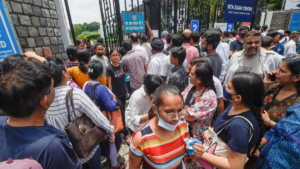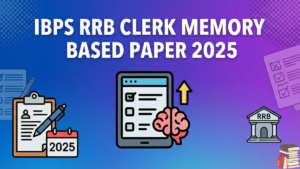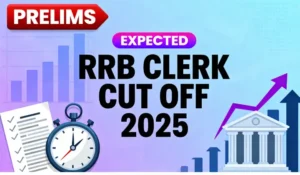Directions (1-5): Study the information and answer the given questions:
Ten friends are sitting in two parallel rows containing five people each in such a way that there is an equal distance between adjacent persons. In row 1 – A, B, C, D, and E are seated (but not necessarily in the same order) and all of them are facing south. In row 2 – P, Q, R, S and T are seated (but not necessarily in the same order) and all of them are facing north. Therefore, in the given seating arrangement, each member seated in a row faces another member of the other row. All of them working in different banks like, PNB, BOB, BOI, SBI, RBI, IOB, UBI, CBI, IDBI, and SIDBI but not necessarily in the same order.
A sits third to left of one who works in BOB (One of them sits to extreme end of the row). Immediate neighbor of A faces T, who works in RBI. Only one person sits between T and Q, who works in SBI. Q does not sit any extreme end of the row. E works in PNB and faces Q. Immediate neighbor of Q faces the person who works in BOI. There are two persons sit between B and the person who works in BOI. R works in IDBI and faces B. Immediate neighbor of C faces the person who works in SIDBI. Immediate neighbor of Q does not face the person who works in IOB. P works in UBI.
Q1.Who sit at the extreme end of the row?
(a) B,C,R,S
(b) B,C,P,Q
(c) T,R,B,C
(d) T,R,E,A
(e) R,C,D,T
Q2.D works in which bank?
(a) PNB
(b) RBI
(c) BOB
(d) CBI
(e) IOB
Q3. B faces which of the following person?
(a) P
(b) R
(c) Q
(d) S
(e) T
Q4. Which of the following information is NOT true regarding D?
(a) D is immediate neighbor of B.
(b) D sits second to left of E.
(c) D sits second to right of A.
(d) D faces P
(e) D works in CBI
Q5. Who works in BOI?
(a) A
(b) B
(c) C
(d) P
(e) Q
Q6. A and B are sisters. A is the mother of D. B has a daughter C who is married to F. G is the husband of A. How is B related to F?
(a) Sister-in-law
(b) Mother-in-law
(c) Mother
(d) Brother
(e) None of these
Q7. A is father of X; B is mother of Y. The sister of X and Z is Y. Which of the following statements is definitely not true.
(a) B is the mother of Z.
(b) X is the sister of Z.
(c) Y is the son of A.
(d) B has one daughter.
(e) B is the wife of A.
Q8. Surmai walked 6km facing towards East, then she took a right turn and walked a distance of 9km. She then took a left turn and walked a distance of 6km. How far is she from the starting point?
(a) 15 km
(b) 21km
(c) 18km
(d) 15 m
(e) None of these
Q9. Neha walks 10km towards the South. Turning to the left, she walks 20km and then moves to her right. After moving a distance of 20km, she turns to the right and walks 20km. Finally, she turns to the right and moves a distance of 10km. How far and in which direction is she from the starting point?
(a) 10km North
(b) 20km South
(c) 20km North
(d) 10m South
(e) None of these
Q10. Which of the following symbols should replace the question mark (?) in the given expression in order to make the expressions P > A as well as T ≤ L definitely true?
P >L ? A ≥ N = T
(a) ≤
(b) >
(c) <
(d) ≥
(e) Either ≤ or <
Q11. Which of the following should be placed in the blank spaces respectively in the same order from left to right) in order to complete the given expression in such a manner that makes the expression A < P definitely false?
__ ≤ __ < __ > __
(a) L, N, P, A
(b) L, A, P, N
(c) A, L, P, N
(d) N, A, P, L
(e) P, N, A, L
Q12. Statements: All plastics are glass. Some sponges are glass. All sponges are clothes. All clothes are liquids.
Conclusions:
I. All liquids are sponges.
II. Some plastics are clothes.
III. All glass are plastics.
IV. All liquids are clothes.
(a) None follows
(b) Only either II or IV follows
(c) Only IV follows
(d) Only III and IV follow
(e) None of these
Q.13 Statements: All sands are beaches. All shores are beaches. Some beaches are trees. All trees are hotels.
Conclusions:
I. Some shores are hotels.
II. All beaches are shores.
III. Some beaches are hotels.
IV. Some sands are trees.
(a) None follows
(b) Only II follows
(c) Only either I or III follows
(d) Only IV follows
(e) None of these
Q14. Statements: All parrots are pigeons. Some crows are pigeons. Some sparrows are crows. All sparrows are koels.
Conclusions:
I. Some koels are crows.
II. Some parrots are crows.
III. Some sparrows are pigeons.
IV. No crow is a parrot.
(a) Only I follows
(b) Only III follows
(c) Only I and either II or IV follow
(d) Only either I or III follows
(e) None of these
Q15. Statements: All chairs are tables. All tables are cushions. Some cushions are trolleys. All trolleys are lamps.
Conclusions:
I. Some lamps are tables.
II. Some trolleys are chairs.
III. Some cushions are lamps.
IV. All chairs are cushions.
(a) Only I follows
(b) Only III and IV follow
(c) Only either I or II follows
(d) All follow
(e) None of these





 IBPS RRB Clerk Prelims Exam Analysis 202...
IBPS RRB Clerk Prelims Exam Analysis 202...
 IBPS RRB Clerk Memory Based Paper 2025, ...
IBPS RRB Clerk Memory Based Paper 2025, ...
 IBPS RRB Clerk Expected Cut off 2025, Ch...
IBPS RRB Clerk Expected Cut off 2025, Ch...








